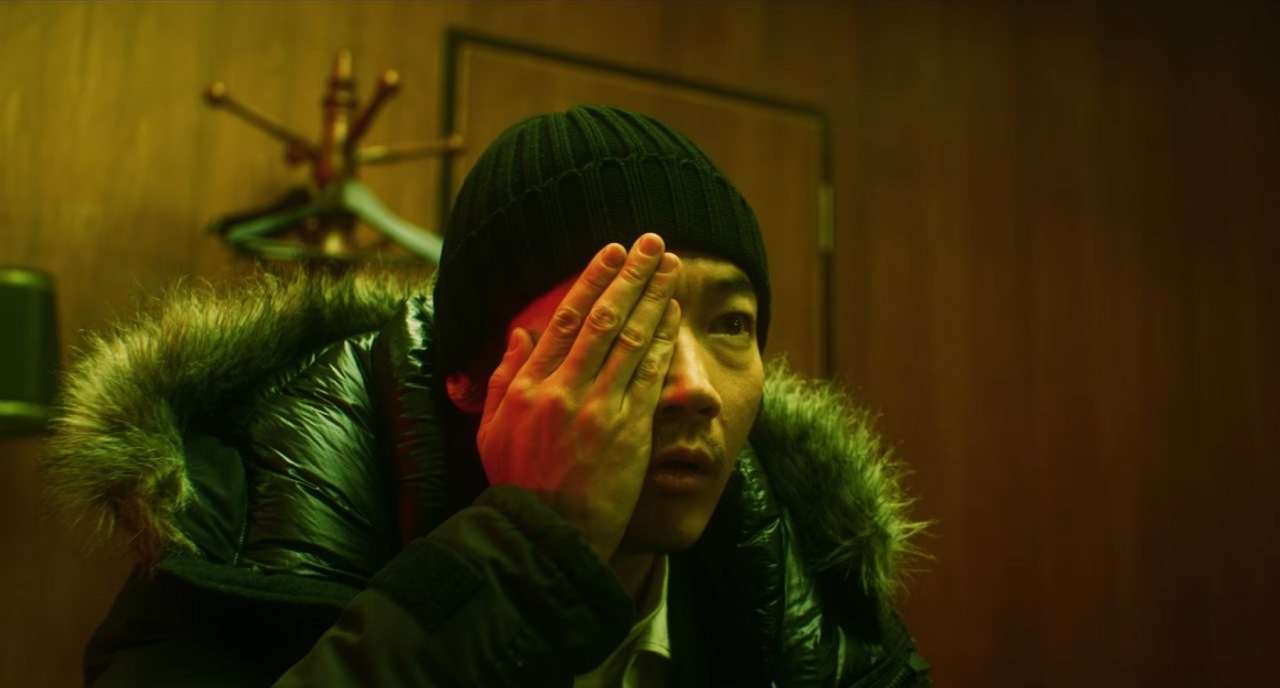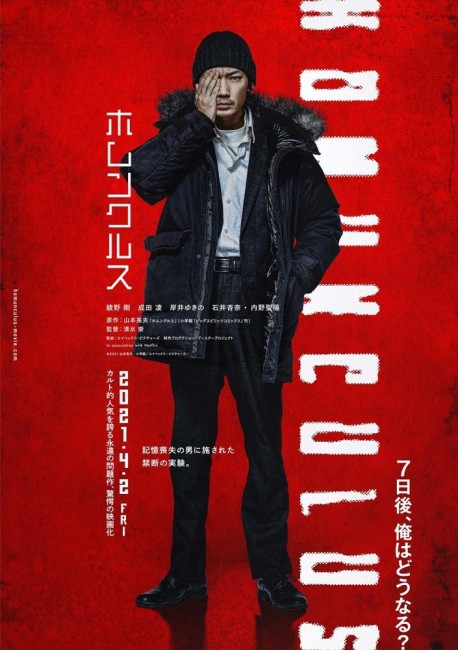Japan. 2021.
Crew
Director – Takashi Shimizu, Screenplay – Naruki Matsushisa, Eisuke Naito & Takashi Shimizu, Story – Hideo Yamamoto, Based on the Manga by Hideo Yamamoto, Producers – Masami Furukusa, Harue Miyake & Chikako Nakabayashi, Photography – Jun Fukomoto & Tokuju Ichikawa, Music – ermhoi & Ayatake Ezaki, Visual Effects Supervisor – Naotaru Takahashi, Visual Effects – Studio Buckhorn, Studio Voxel & SultamediaFX, Production Design – Yoko Sagae. Production Company – Really! Mad+Pure/Peek a Boo Films.
Cast
Go Ayano (Susumu Nokoshi), Ryo Narita (Manabu Ito), Yukino Kishii (Nanako/Chihiro), Seiyo Uchino (Kumicho), Anna Ishii (High School Student)
Plot
In Tokyo, Susumu Nokoshi lives homeless in his car even though he has money to do otherwise. He is asked by medical intern Manabu Ito to take place in a paid seven day experiment in trepanning where a hole will be drilled in the front of his skull that will open up hidden areas of the brain. Nokoshi refuses until Ito has his car towed away. Nokoshi agrees to undergo the operation. However, when he emerges from it, he finds that when he looks out of his left eye, he can now see people as bizarre creatures and that the operation has given him newfound ability to see their inner traumas given outward expression.
Takashi Shimizu is the Japanese director who is best associated with the Ju-on/The Grudge series of ghost stories. Shimizu created the series in School Ghost Story G (1998) and directed six of the films, including the English-language remake The Grudge (2004). Outside of that Shimizu has made quite a reasonable body of films in the horror genre, including several English-language works. (See below for a full list of Takashi Shimizu’s films).
Here Shimizu adapts Homunculus, a manga that ran between 2003 and 2011 in Weekly Big Spirit Comics. It was one of the works from Hideo Yamamoto, who also created Ichi the Killer (1998-2001) that was adapted into the film by Takashi Miike with the outrageous Ichi the Killer (2001), among other works.
Homunculus holds your attention from its opening scenes where we are introduced to Go Ayano living in his car, hanging out with the men at a nearby homeless camp, but then going to eat a meal in a restaurant (it is never made clear throughout where he gets his money from). That is before the introduction of the bizarre figure of Ryo Narita who implores Go to join his experiments in trepanning. All of this is a perfect recreation of the set-up of the manga.
Following the operation comes the introduction of Go Ayano’s newfound abilities that occur when he places a hand over his left eye. We get a view of some of his visions – seeing people on the street with speed rotator hips, lightbulb heads, a person split in two walking hand in hand with their other half, others turned into cubed form, people having conversations with plant beings, The premise seems to harken back to something of the mind-bogglingly bizarre Hong Kong film Mad Detective (2007) about a detective who could see people’s inner personalities whereas here Go can see people’s inner traumas given symbolic expression.

The film then follows various incidents as Go Ayano uses his newfound power to help people. There is a piece where he encounters a Yakuza head (Seiyo Uchino) who keeps appearing as a transformer robot and threatening to cut fingers off with a blade, before Go reduces him to his childhood traumas – the bizarre image of the transformer splitting open to reveal the boy hidden inside – whereupon the kumicho redeems his ways. The other is of Anna Ishii as a high school girl who keeps turning into sand before a bizarre sequence in Go’s car where he holds her down and forces her to confront her underlying sexual tensions – the bizarre image of her transforming into a creature made of a sand with a sand vagina for a head. (Although this segment left me unsure how her traumas were healed by Go apparently biting into the calf of her leg).
The story often felt like it needed tightening. I could easily see this having been made as a US film and losing a good 30 minutes of its 1 hour and 55 minute runtime. The latter third of the story less interestingly abandons much of the central concept about the expression of inner traumas and focuses on the complicated backstory between Go Ayano and Yukino Kishii as the woman who may or may not have led to his being there and without memory.
Elsewhere, Takashi Shimizu has directed six films in the Ju-on universe with Ju-on (2000), Ju-on 2 (2000), Ju-on: The Grudge (2003) and Ju-on: The Grudge 2 (2003), and the English-language remake The Grudge (2004) and its sequel The Grudge 2 (2006). Outside the Ju-on/Grudge series, he has made Tomie: Rebirth (2001), the strange and unclassifiable Marebito (2004), the ghost story Reincarnation (2005), an episode of the anthology Ten Nights of Dreams (2006), The Shock Labyrinth (2009), Rabbit Horror 3D (2011), the live-action version of Hayao Miyazaki’s Kiki’s Delivery Service (2014), the English-language airplane horror 7500 (2014), A Rain Woman (2016), Innocent Curse (2017), Howling Village (2019), Suicide Forest Village (2021), Oxhead Village (2022), Immersion (2023) and Sana (2023).
Trailer here


